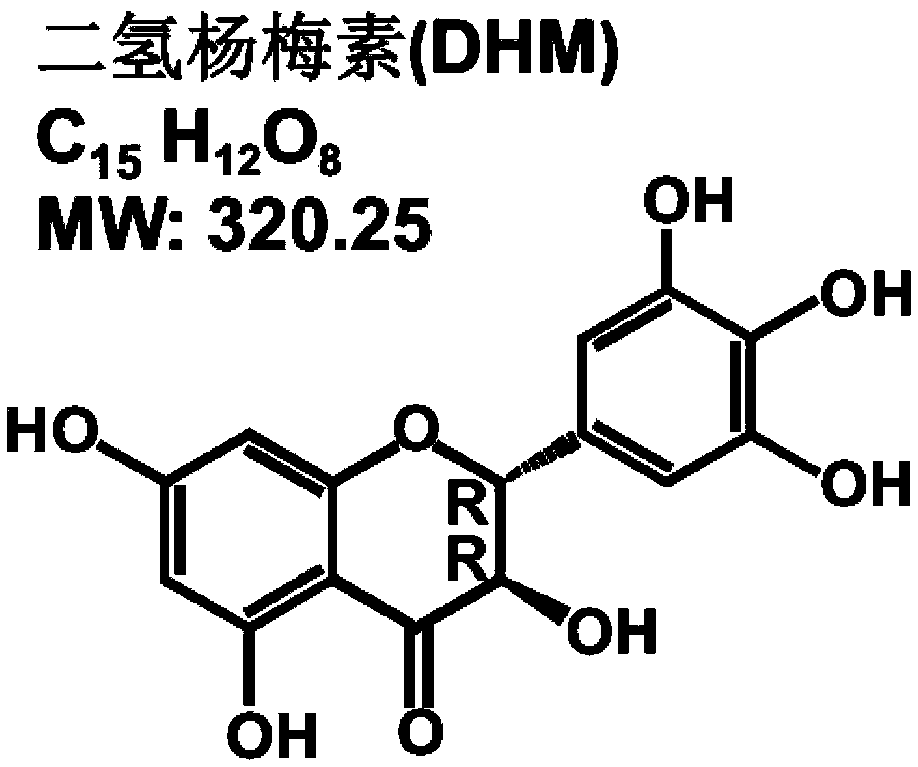Anti-haze drug, anti-haze mask of anti-haze drug and application of dihydromyricetin in control of haze and treatment of seasonal influenza
A dihydromyricetin and anti-haze technology, applied in the field of biomedicine, can solve problems such as the absence of dihydromyricetin, and achieve the effects of preventing and reducing damage
- Summary
- Abstract
- Description
- Claims
- Application Information
AI Technical Summary
Problems solved by technology
Method used
Image
Examples
Embodiment 1 2
[0055] Example 1 Dihydromyricetin control haze experiment
[0056] The experimental animals were divided into three groups (A: normal group, referring to the normal air used in the test aerosol machine in the experiment; B: polluted group, referring to the experiment, the test aerosol machine used SO 2 500 μg / m 3 ;C: Contaminated treatment group, refers to the experimental aerosol using SO 2 500 μg / m 3 , and then mixed with dihydromyricetin 5mg / L).
[0057] For the first three days, the daily treatment method for each group:
[0058] Group A: 5% CO 2 / 95%O 2 , input continuously for 10 minutes.
[0059] Group B: test aerosol using SO 2 500μg / m 3 (concentration 0.5μg / L), mixed with air-conditioning exhaust gas, air pressure 40psi, 10 minutes continuous input.
[0060] Group C: test aerosol using SO 2 500μg / m 3 (concentration 0.5μg / L) was mixed into the air-conditioning exhaust gas, and then mixed with dihydromyricetin 5mg / L, the pressure was 40psi, and the input was ...
Embodiment 2 2
[0064] Embodiment 2 Dihydromyricetin against human influenza A (H1N1) virus infection
[0065] In this example, human influenza A (H1N1) virus 252 (±34) μg / mL particles were used to determine the antiviral effect of dihydromyricetin. The steps are: H1N1 virus particles are co-cultured with dog kidney cells in a medium containing dihydromyricetin for a total of 2 hours, and then washed 3 times. Filter through a filter and remove unbound compounds with common culture medium. Virus particles were harvested and analyzed using a direct binding assay—the dihydromyricetin-bound and unbound fractions were then compared.
[0066] Experimental results such as image 3 As shown, the 50% inhibitory concentration (IC50) of dihydromyricetin to H1N1 is 2.4 μg / mL (8 μM), while the concentration (IC100) of 100% inhibition of H1N1 virus infection is 8 μg / mL (27 μM). It shows that dihydromyricetin has obvious dose-dependent inhibitory effect on H1N1 virus infection.
[0067] We further analy...
Embodiment 3 2
[0068] Example 3 Dihydromyricetin resists respiratory infection caused by streptococcus
[0069] In this experiment, experimental white mice were used to place 100 μl of streptococcus preparation (culture medium) into the oral cavity through the upper incisors to eliminate the liquid intake of the experimental white mice. Inflammation was assessed on day 1 and day 7 post-infection.
[0070] A: The normal group refers to that in the experiment, after placing 100 μl (microliter) of physiological saline in the oral cavity, the liquid intake of the experimental white mice was removed for 30 minutes. From the first day, give 1cm every day 3 Drug-free agar frozen for 7 days.
[0071] B: Contaminated group means that in the experiment, 100 μl of streptococcus preparation (culture medium) was placed in the oral cavity, and the liquid intake of the experimental white mice was removed for 30 minutes. From the first day, give 1cm every day 3 Drug-free agar frozen for 7 days.
[0072...
PUM
 Login to View More
Login to View More Abstract
Description
Claims
Application Information
 Login to View More
Login to View More - R&D Engineer
- R&D Manager
- IP Professional
- Industry Leading Data Capabilities
- Powerful AI technology
- Patent DNA Extraction
Browse by: Latest US Patents, China's latest patents, Technical Efficacy Thesaurus, Application Domain, Technology Topic, Popular Technical Reports.
© 2024 PatSnap. All rights reserved.Legal|Privacy policy|Modern Slavery Act Transparency Statement|Sitemap|About US| Contact US: help@patsnap.com










